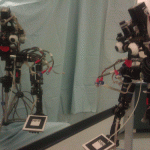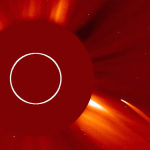
A fruit fly is tethered in a light-emitting diode (LED) flight arena. Image: Floris van Breugel
A fruit fly suspended in a magnetic field alters its flight path depending on cues it receives from light polarisation.
University of Washington professor Michael Dickinson, along with Peter Weir, a doctoral student at the California Institute of Technology, noted that insects such as monarch butterflies and locusts maintain a constant heading while migrating thousands of kilometres across continents. Additionally, bees and ants hunting for food successfully find their way hundreds of meters back to their nest without a problem. This led scientists to believe that the animals must possess a compass of sorts.
Dickinson and Weir published their findings in the journal Current Biology in January, where they provide details on how a fruit fly suspended in a magnetic field alters its flight path depending on cues it receives from light polarisation. To assess how insects orient themselves, the researchers examined the behaviour of Drosophila melanogaster, the common fruit fly, in outdoor lighting conditions in a specially designed arena atop a building. They used a light-cured glue to attach the insects to a metal pin, which was then placed within a magnetic field that allowed the flies to move and rotate naturally but held them in place. During the hour before and after sunset, the headings of flies relative to the position of the arena were recorded for 12 minutes. The arena was rotated 90 degrees every three minutes, and when natural light was not altered by optical filters some of the flies compensated for the rotations and maintained a consistent heading. When the arena was covered with a circularly polarising filter, eliminating natural linear polarisation light patterns, the flies did not shift their heading significantly in response to arena rotations.
The results indicate Drosophila has the ability to coordinate eye and brain functions for basic navigation using light polarisation patterns. Demonstrating that fruit flies can navigate using cues from natural skylight makes it easier to use genetics research to better understand the complex capability and exactly how it is implemented in the brain.
Understanding polarisation patterns opens new possibilities in navigation for seafarers, who for millennia have depended on the sun to know their position in the world. Modern technologies have allowed seafarers to navigate based on GPS and satellite signals, however, such techniques are not bulletproof. According to Dickinson, if there’s even a small patch of clear sky in a fruit fly’s broad range of view, the natural light patterns can provide location information.
Source: Eureka Alert






